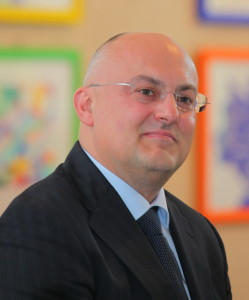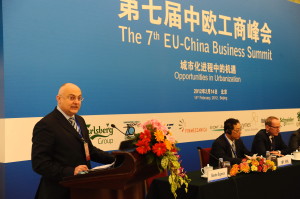Massimo Bagnasco graduated in Architecture from the University of Genoa in 1996. He has worked for Progetto CMR since 2004 when he set up their offices in Beijing, Shanghai and Tianjin. In addition to being managing partner he also functions as client leader on many projects, such as the Vantone Citylogic ‘Xixian Great City’ Urban Planning project, and the Euro Sino Invest ‘EU-China Sustainable Urbanisation Park’ Masterplan.
Bagnasco is a frequent contributor to publications on the topic of architecture. He served as Vice Chairman of the European Chamber’s Construction Working Group from 2008 until 2010 when he was elected as Chairman.
Why did Progetto decide to build offices in China?
When Massimo Roj, our global CEO, first came to China in 2002, we didn’t consider establishing branch offices in China. He was part of an institutional delegation and got a chance to meet the mayor of Tianjin, who invited us to join some master planning competitions in Tianjin
As such, I joined Progetto CMR to lead a hotel design, and I was only supposed to stay 6 months in China.
Has there been a noticeable increase in business since China’s urbanisation process began to gather pace?
China’s Urbanisation process started when Deng Xiao Ping raised the reform and opening-up policy in the 1980s leading to realty booms in Shenzhen and Shanghai Pudong. Since then there has been a huge increase in business opportunities in all the sectors because the city development involves them all.
Part of Progetto’s methodology is rooted in ‘sustainable integrated design’, can you explain a little about this?
I am firmly convinced that architecture’s mission is to design a better quality of life: architecture must focus on the human scale. Cities belong to the citizens who live in them. We need a new mindset, a new concept of sustainability that takes in how mankind relates to the city, with due consideration for the local context and culture, so as to make us capable of creating new models of settlements.
Integrated design is at the basis of sustainable design; it is the only design methodology capable of controlling costs, time and quality of a project. The search for innovation is the engine that drives each project.
Progetto are involved in the EU-China Sustainable Urbanisation Park (SUP). How important a project is this?
The SUP project is the first real estate project initiated under the EU-China partnership on Urbanisation.
The project, invested and developed by the European Company Euro Sino Invest, will be realised in Shenyang and its development will be based on the idea of a ‘European community’, combining the main functions of a city district in a sustainable way. Since urbanisation is a really broad topic, this project will be a consistent business opportunity for a lot of EU Companies to promote their best practices, know-how and equipment.
What other urbanisation projects are you currently involved in?
We have been recently involved in the conservation and utilisation zoning plan for the city of Jingzhou, in Hubei Province. The plan we developed for the 12 square kilometre area has given primary importance to many historical sites and monuments in the city, turning them into focal points for the revitalisation of the whole city. Our design team drew inspiration from some famous Italian historical cities, which actually share some similarities with Jingzhou.
In what key areas do you think China can learn from European models of urbanisation?
The compact and polycentric urban system of Europe is well recognised as an example of sustainable development. Preserving the identity of cities is important to create a harmonious life and ensure socio-cultural integration. China can also learn from Europe’s administrative concept, legal entities and jurisdictions as well as their positive response to traffic pollution, urban decline, inequality and sprawl.
As China’s urbanisation process continues, do you feel there will be increasing opportunities for European companies in the construction sector?
In the first instance the construction sector will be one of the main beneficiaries of urbanisation, especially the green building and energy saving industries. How much could be in hands of EU companies but it depends on the overall situation with relation to market access, revision of the role played by SOEs, public procurement regulations and protection of intellectual property rights.
What concerns do you have about China’s urbanisation process?
There needs to be a balance between urban and rural development; the future of urbanisation requires a holistic approach. New forms of governance, that are both well structured and flexible, are required to respond to the challenges. Urban-rural integration must be considered as an overall unitary system comprised of strong relationships between the individual components – the cities and the villages.
China needs to be mindful of its cities’ backgrounds and ensure that it re-establishes links between the history and culture of a place and its citizens. There needs to be a sustainable-life approach that embraces civic engagement, creativity, innovation and social cohesion.
Smaller, satellite cities should also be promoted, and these should be linked but also self sufficient and designed to be ecologically sound. This will safeguard against mass migration to the big cities.
What do you see as being China’s biggest challenge?
China is shifting the focus from heavy infrastructure development of roads and railways etc, to a softer approach — healthcare, education and culture — because these are the main needs of the people. We must always keep in mind that cities are made by people, so humans should always be the focal point. Reforms are necessary and this point is well known by the leadership.
Previously China could make a choice between economic restructuring and maintaining growth. Now economic restructuring is necessary to maintain growth. How China will pass through this period of social and economical reform is the main challenge.
Are you confident that China’s urbanisation process will, for the large part, result in sustainable cities that are environmentally friendly?
In order to achieve this it will be necessary to implement reforms to the present system. China has already made huge improvements recently, but due to the incomparable size of its urbanisation process it is not enough.
As is the case in Europe, there needs to be good governance, rule of law, and tax reductions and incentives that could make green technologies and equipment more affordable.
It is also important to develop new systems for municipalities to finance themselves to avoid over capacity in the real estate sector. Under the current system the main way to finance their development is still by land sale. This could lead to incorrect urban planning that doesn’t reflect the actual need.
Local government are still mainly concerned with achieving the highest GDP growth. Often this indicator is not aligned with a green and sustainable city development. A different evaluation system could be a really great opportunity for improvements and win-win cooperation.
Can you tell us a little about the work that the Chamber’s Construction Working Group is doing in the field of urbanisation?
The Construction Working Group has been very active on this topic, since before the official signature of the EU-China partnership.
In the 2012 Position Paper we added, as the first key recommendation: “promote sustainable urban development” in order to open up constructive cooperation with our Chinese and EU institutional counterparts and reinforce our strong belief in the importance of a deep and close dialogue on this topic. Furthermore, the activities of the Construction Working Group will be closely aligned with that of the EU-China Political Summit where urbanisation will be one of the key topics.
The implementation is definitely bringing bright results, such as the organisation of, and participation in, several forums and conferences, and a training programme for Chinese officials, which is executed in cooperation with China Academy of Governance.
Other concrete examples are the lobbying results with departments of National Development and Reform Commission (NDRC), in particular the China Centre for Urban Development, which is the official and unique secretariat of the ‘EU-China Partnership’.
There has also been good collaboration with the EU Delegation in Beijing by taking part in several institutional missions of HE Ambassador Ederer.
Sustainable urbanisation involves many other sectors and working groups. We welcome the opportunity to strengthen the other industries involved, providing our experience and direct guidance in order to create a bigger and stronger team.




Recent Comments